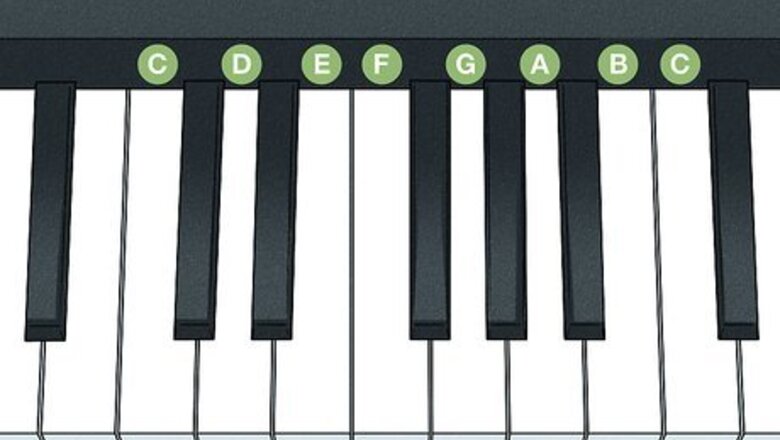
views
Label the notes on your piano or keyboard.
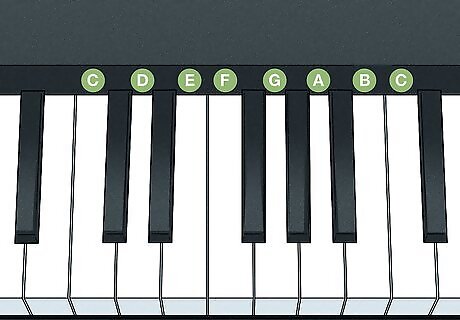
Use stickers to help locate each note if you're a beginner. If you’re just starting out learning the piano and haven’t memorized which key plays which note (or if you just need a friendly reminder), it might help to put little stickers on each key. Write each note (A, B, C, D, E, F, G) on a separate sticker and place them on the corresponding keys. Then, if you know how to read sheet music, print out a copy for yourself. Place the stickers on the end of the keys that are closest to you so that you can see them better. Don’t write directly on the keys themselves. This might damage your piano. “Chopsticks” doesn’t require you to play any of the black keys, so just make stickers for the white keys. Print out this PDF file of the sheet music for “Chopsticks.” If you don’t know how to read sheet music, simply write down the letters of the notes you’ll be playing in order and use that as a reference.
Place your left index finger on center F and right on center G.
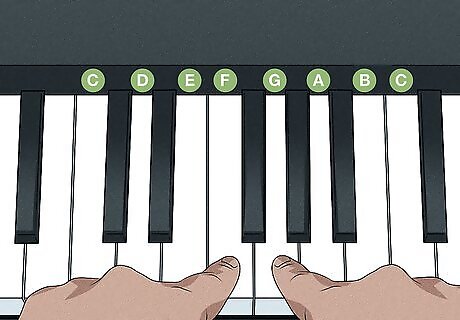
Position your index fingers so that the outsides rest on the keys. Turn your hands sideways so that your pinkies are closest to the keyboard. Place your left index finger on the F key in the center of the keyboard and place your right index finger on the G key directly next to it. You’ll use your two index fingers to play the entire song and press down on the keys as though you’re chopping something. In fact, that’s where this fun song gets its iconic name. Another option is to play the song with your pinkies, which was how the composer, Euphemia Allen, originally intended for this song to be played. To play with your pinkies, curl your hands into fists and stick out your pinky fingers. Rest the outsides of your fingers on the keys and bring them down in a chopping motion to play each note.
Use a 3/4 time signature to play the song.
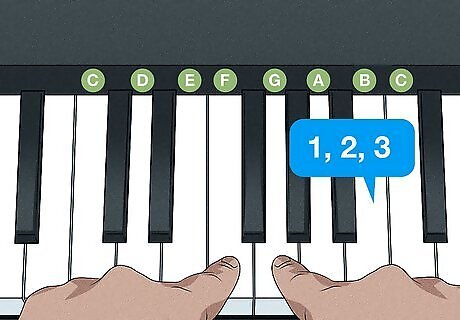
Count 1, 2, 3 repeatedly to get the timing down. “Chopsticks” is a waltz written with a 3/4 time signature. This means that each measure has 3 beats. To get the proper timing down for the tune, count 1, 2, 3 out loud or in your head repeatedly and make sure that the intervals between each number are the same length. Another option to keep time is to use a metronome. Either use a mechanical metronome, a digital metronome, or even a metronome app. Set your metronome at around 80 bpm (beats per minute) when you’re starting out. This speed is slow enough to let you get the hang of playing the notes. EXPERT TIP Melissa McDermott Melissa McDermott Music Instructor Melissa McDermott is a Musician and accomplished Social Media Manager at coBranding Studio based in New York City. She has over seven years of experience teaching piano and music theory, she currently works as a Piano Instructor at O DiBella Music Inc. Additionally, she specializes in creating meaningful, informative, and quality social media content for health and wellness brands and musicians. Melissa received her B.A. in popular music studies from William Paterson University. Melissa McDermott Melissa McDermott Music Instructor Playing Chopsticks on the piano takes coordination between your fingers and a sense of timing. The fun of this simple duet is moving both hands together, hitting the notes in sync. Starting with just two fingers helps beginners practice basic piano skills like coordination and keeping rhythm. Using your index fingers like chopsticks captures the playfulness of the game and makes it an easy introduction to piano.
Play F with your left finger and G with your right 6 times.
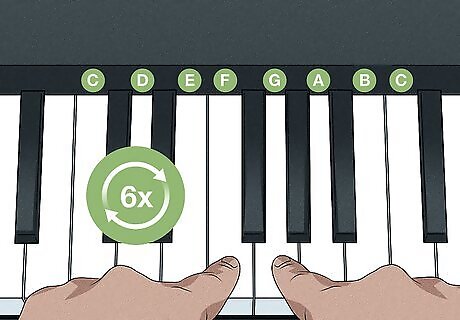
Play F and G together for the first 2 measures. With your left index finger on the center F key and your right index finger on the center G key, play the two notes at the same time 6 times. Make sure that you’re keeping time and playing each note on a separate beat as you count 1, 2, 3 out loud or in your head.
Play E with your left finger and G with your right 6 times.
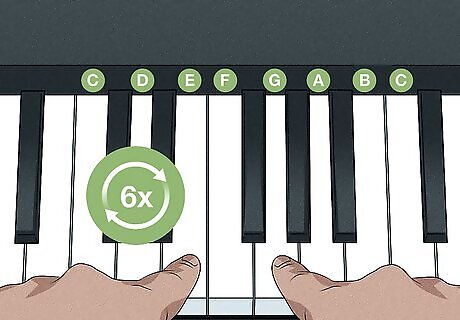
Play measures 3 and 4 by pressing the E and G keys together. Keep your right index finger on the G key and move your left index finger to the E key. This is the key directly to the left of the F key.
Play D with your left finger and B with your right 6 times.
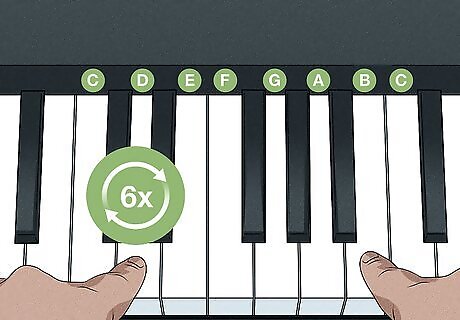
Complete measures 5 and 6 by playing D and B together. Move your left index finger 1 key to the left and place it on the D key. At the same time, move your right index finger 2 keys to the right and place it on the B key. Play the notes 6 times ina. row.
Play the C keys 1 octave apart 3 times.
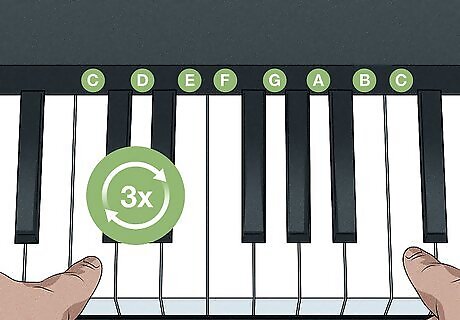
Play the lower C with your left finger and the higher C with your right. Shift your left index finger down 1 key to the left and place it on the C key. Move your right index finger 1 key to the right and place it on the other C key that’s 6 keys away from your left finger. Play these 2 notes together 3 times to complete measure 7.
Play C, D, E with your left hand and C, B, A with your right.
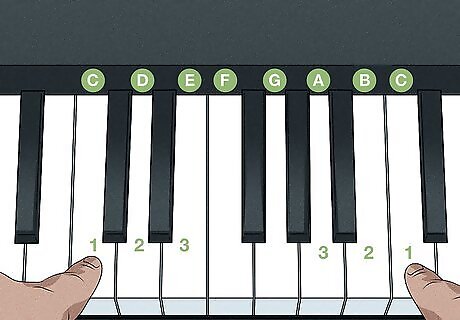
Play the 2 Cs once more, followed by D and B, then E and A. Keep your index fingers on the 2 C keys and play the 2 notes 1 more time. Then, move your left finger back to the D key 1 space to the right. Move your right finger to the B key 1 space to the left and play these notes together once. Finally, move your left finger 1 more key to the right and place it on E and shift your right finger 1 space to the left so that it rests on A. Play these two notes together to finish measure 8.
Repeat measures 1-6.
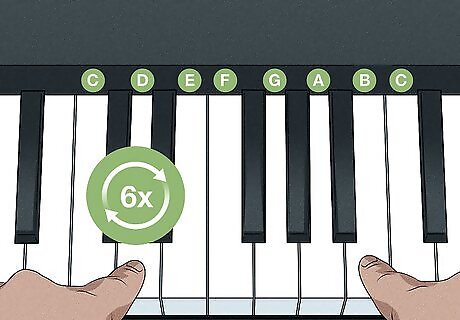
Play F and G 6 times, E and G 6 times, and D and B 6 times. Lucky for you, you already know how to play the next few measures! Move your left index finger back to the F key at the center of the keyboard and your right index finger to the G key directly to the right of it. Play this combo 6 times, then play E (left hand) and G (right hand) 6 times. Finally, play D (left hand) and B (right hand) 6 times. Now you’ve completed measures 9-14.
Play the 2 C keys, rest for 1 beat, then play F and G.
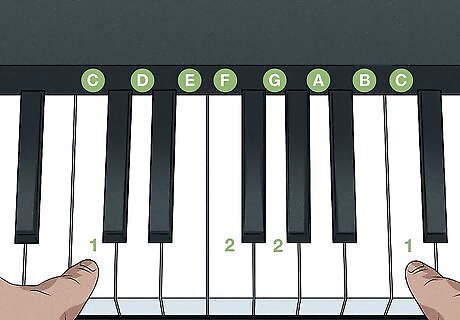
Play C then F with your left hand and C then G with your right. Bring your fingers back to the 2 C keys you played in measure 7. Play these 2 notes together once, then take your hands off the keys and pause for 1 beat. Finally, bring your fingers back to the F and G keys at the center of the keyboard and play them together 1 time. This completes measure 15.
Hold the 2 C keys down for 2 beats.
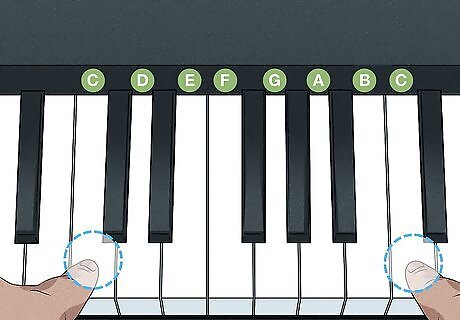
Play the 2 Cs that are 1 octave apart one more time to finish the song. Move your fingers back to the C keys that are 1 octave apart and play them together one last time. Hold them down for 2 beats to signal the end of the song. Congrats! You’ve successfully played “Chopsticks.”
















Comments
0 comment